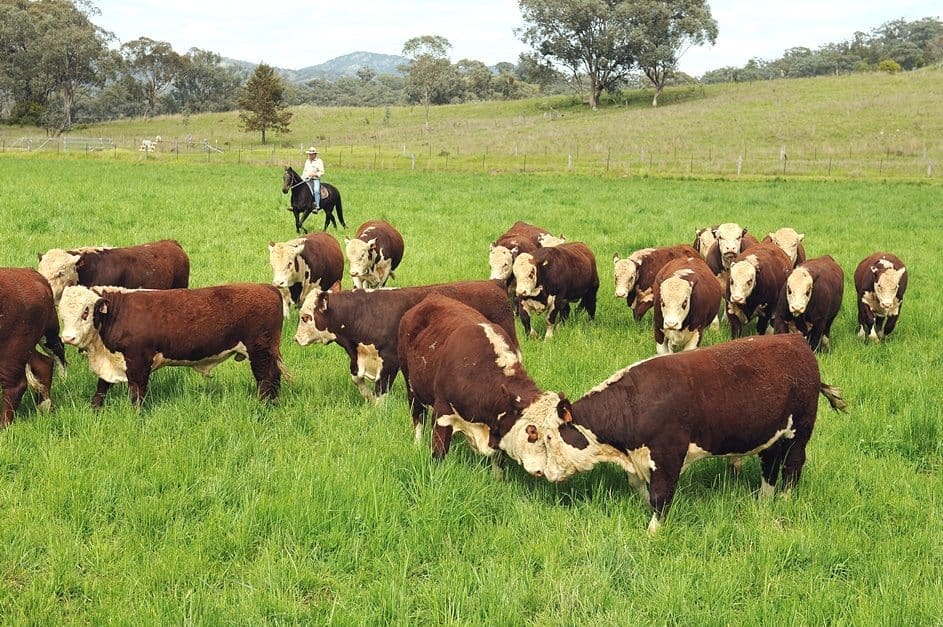
COMMERCIAL bull buyers prepared to pay $20,000, $25,000 and even $30,000 for herd bull replacements are the real ‘engine room’ driving what is turning out to be an unbelievably good 2021 autumn bull sellling season.
Just as sales averaging $10,000 became reasonably commonplace during the spring sales period late last year, quite a number of fixtures during the recent autumn bull sales period have been routinely breaking $12,000 averages.
And many are doing it without one or two outrageously priced ‘headline grabbers’ at the top. There have been plenty of sales averaging $10,000 to $12,500 for bulls over the past two months, where the top price has been just $20,000 or less.
That suggests one thing: it’s been the commercial bull buyer seeking meaty, fast growing bulls to generate high performance weaners, feeder steers or grassfed finished steers that have been driving the bus. And as seen last spring, 100 percent clearance rates at sales are now almost routine.
The strong results this autumn have in fact been across a number of breeds, and most, if not all regions.
Here’s just a brief sample to illustrate this (See Beef Central’s Recently completed bull sales summaries for more detail):
- Rennylea Angus Autumn Bull Sale held this afternoon in southern NSW saw a total clearance of 108 bulls sold to $30,000 to average $12,537.
- Bonnydale Simmentals in WA yesterday sold 78/79 bulls topping at just $19,500, but still averaging $9526
- Wormbete Simmentals in NSW on Friday sold all 26 bulls offered, and averaged $10,462 despite a top price of just $16,000.
- Hicks Beef NSW sold 32/32 Black Composites (plus 28/28 Red Angus and Red Composites) averaging $10,531 with a top of $20,000
- Gingin Angus Sale in WA sold all 50 Angus bulls offered, averaging $11,982 with a top price of $24,000
- Te Mania’s exceptional sale near Mortlake Vic last Wednesday averaged $13,036 for a total clearance of 169 Angus bulls, with a top price of $65,000
- Dunoon Angus, Holbrook NSW sold all 143 bulls offered last week, averaging $13,832 with a top of $45,000.
- Wattle Grove Speckle Park Sale at Toowoomba sold 29 bulls averaging $12,603, with a top of $65,000.
Results like this suggest one thing: that bull prices have managed to find a new level in early 2021, after already hitting dizzying all-time highs during last year’s spring sales period.
Holbrook (southern NSW) based Elders stud stock agent, Philip Gledhill, has been in the thick of the action over the recent autumn bull sales period.
“I’d sale the current bull market is at least 30-40 percent above the equivalent autumn sales last year, and probably 10-20pc above many corresponding sales seen last spring,” Mr Gledhill told Beef Central.
“This time last year, February and March were still pretty tight, season wise, in a lot of places,” he said. “This area probably held up better than most, but even after rain, many people were still awaiting grass growth. Then COVID arrived, and it started to disrupt sales from March on.”
Some of the recent sales could have done with another 10-15 bulls in the catalogue, quite easily, without affecting the result.
He said the recent Hicks Beef sale (across Black and Red composites plus Red Angus) averaged just short of $9200, against an autumn sale last year in the ‘early sixes’ – up well over 40pc, year-on-year. Last week’s Dunoon Angus sale averaged $13,832, compared with their spring sale last year somewhere in the ‘nines’ – up around 30-35pc.
“Pass-in rate has been very, very low – and often non-existent,” Mr Gledhill said. “It’s evident there are a few more females around than some stud breeders had anticipated. Some of the recent sales could have done with another 10-15 bulls in the catalogue, quite easily, without affecting the result.”
Injemira Herefords late last month also had an exceptional result, he said, averaging $12,379 for 95 bulls, and selling to a new breed record of $160,000 (see breed records list, click here).
“But even if you had pulled out those three highest price Injemira bulls last week, the rest would have still averaged about $10,000. It was arguably the strongest Hereford sale ever seen in Australia.
“It helped that they were an exceptional line of Hereford bulls to sell, but equally, Injemira has built a very big catchment area of clients – not just local – and they all wanted bulls.”
Have bull prices now gone past commercial cattle values?
Beef Central asked Mr Gledhill whether autumn 2021 sale bulls had now gone ‘past commercial cattle’ in terms of relative value.
“I don’t think so. These extraordinary bull prices are only in context with the red hot cattle market across Eastern Australia. This time last year, a 320-330kg steer was worth $1150 to $1250, while bulls were making $6500 or thereabouts – five to five-and-a-half steers in value.
This February, those same steers are worth $500 more, at around $1800. Using the Hicks bull sale as a comparison, up about 45pc in value compared with last year, the ‘number of steers to buy a bull’ ratio is roughly the same, he said.
Mr Gledhill said the exceptional averages being generated at many bull sales this autumn were being achieved often without the statistical benefit of one or two bulls making ‘really big’ money.
“It’s the middle-ground, commercial buyer where the real support is coming from,” he said. “I’ve seen plenty of commercial bull buyers in recent weeks paying $20,000 to in excess of $30,000 for bulls which are going into straight commercial meat-breeding herds.”
“Personally, it hasn’t surprised me to see bull prices continue to climb as they have,” Mr Gledhill said.
“For years, I’ve thought good bulls are too cheap, given the work that goes into producing them. They’re now reaching their true value, in my opinion.”
“The old saying used to be: ten steers to buy a bull. If that still applies and 350kg steers are worth $1800, then people should be thinking $18,000 to buy good replacement bulls.”
“It’s the key reason why these recent sales have been producing such strong results.”
Strong Angus results
Angus Australia’s Andrew Byrne said records collected by the organisation clearly showed that Angus bull values had ‘gone up another notch’ since late last year.

Andrew Byrne
He agreed that a big part of the momentum was coming from commercial buyers.
“Historically, we’ve seen a very close alignment between bull prices and commercial cattle sales – particularly the EYCI,” Mr Byrne said.
“When we track it, it shows a strong correlation, and that’s being seen in the current autumn bull sales market,” he said.
“The other factor is that we’re also in a rebuilding phase, which is further boosting demand.”
With prices lifting even further from where they left off in spring, 2020, the challenge for all seedstock producers now was to make sure they continued to deliver value and performance in the genetics being offered.
“As prices increase, buyers have a right to make sure they are getting bulls which align with their breeding objectives, and are going to perform.”
Will stud managers put away the castration knife?
Asked whether the current super-heated bull price environment presented a temptation for stud breeders to ‘put away the castrating knife,’ Mr Byrne said there might be a ‘little bit’ of a risk in that, but historically, bull breeders had proven very good at adjusting numbers offered to demand.
“There will certainly be more bulls for sale this year than last year, as the female herd recovers, but I’m still seeing fair selection pressure being applied within seedstock herds to ensure that the industry is offered only profitable packages,” he said.



One point to note – several commercial buyers of some of the very high priced bulls sold last week have already sold large quantities of semen from their new acquisitions – in one case, those AI sales have made the bull look ‘quite cheap.’
Good point David. In many cases by the time the buyer has arrived home their $30k odd purchase doesn’t owe them very much at all. In some cases these bulls are also collected and used in AI programs within herd with the bull himself used as a back up. So semen sales and potentially 100 pregnancies in the first joining that person has made a very solid investment.